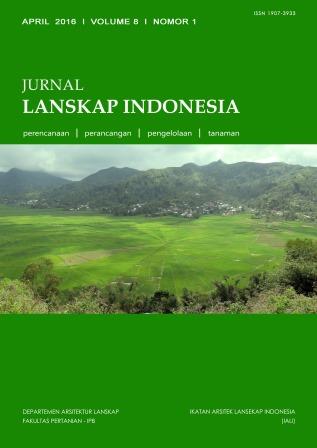KONSEP PENCAHAYAAN (LIGHTING) PADA LANSKAP JALAN LINGKAR KEBUN RAYA BOGOR
Abstract
Kebun Raya Bogor dan Istana Bogor merupakan tempat-tempat penting dan terkenal di kota Bogor. Kedua tempat tersebut dikelilingi oleh jalan utama yang dikenal sebagai jalan lingkar Kebun Raya Bogor. Saat ini kedua tempat tersebut menjadi pusat kota Bogor yang menjadi tempat tujuan wisata domestik maupun mancanegara. Sebagai kota wisata, Bogor perlu memperhatikan penampilannya pada siang hari dan juga malam hari. Penampilan malam hari jalan utama tersebut masih perlu lebih dioptimalkan, khususnya melalui teknik pencahayaan khusus. Penelitian ini bertujuan untuk menyusun desain alternatif pencahayaan lanskap malam hari yang inovatif pada jalur pejalan kaki. Penelitian ini dilakukan dengan metode deskriptif melalui survey lapang dan wawancara untuk memformulasikan konsep pencahayaan lanskap jalur pejalan kaki. Konsep Bogor Exotic Night merupakan konsep utama pencahayaan jalur pejalan kaki tersebut. Jalur tersebut dikelompokan kedalam 5 (lima) kawasan pencahayaan, yaitu kawasan pencahayaan jalan, pencahayaan perkantoran, pencahayaan jasa dan perdagangan, pencahayaan permukiman, dan pencahayaan pendidikan. Konsep pencahayaan yang dihasilkan antara lain pencahayaan dinding, fountain of fortune, harbour of light, welcome light, enlightment, dan lainnya.Downloads
This journal permits and encourages authors to post items submitted to the journal on personal websites or institutional repositories both prior to and after publication, while providing bibliographic details that credit, if applicable, its publication in this journal. However, after the article is submitted and published in this journal, it is fully copyrighted by the Jurnal Lanskap Indonesia or JLI. If excerpts from other copyrighted works are included, the author must obtain written permission from the copyright owner and give credit to the source in the article. Then, the writer or reader is allowed to copy, share, and redistribute articles/material in any form. But it must still include the appropriate source and credit because the article in this journal is licensed by Creative Commons Attribution 4.0 International License (CC BY 4.0).
I. Proposed Policy for Journals That Offer Open Access
Authors who publish with this journal agree to the following terms:
- Authors retain copyright and grant the journal right of first publication with the work simultaneously licensed under a Creative Commons Attribution License that allows others to share the work with an acknowledgement of the work's authorship and initial publication in this journal.
- Authors are able to enter into separate, additional contractual arrangements for the non-exclusive distribution of the journal's published version of the work (e.g., post it to an institutional repository or publish it in a book), with an acknowledgement of its initial publication in this journal.
- Authors are permitted and encouraged to post their work online (e.g., in institutional repositories or on their website) prior to and during the submission process, as it can lead to productive exchanges, as well as earlier and greater citation of published work (See The Effect of Open Access).
II. Proposed Policy for Journals That Offer Delayed Open Access
Authors who publish with this journal agree to the following terms:
- Authors retain copyright and grant the journal right of first publication, with the work after publication simultaneously licensed under a Creative Commons Attribution License that allows others to share the work with an acknowledgement of the work's authorship and initial publication in this journal.
- Authors are able to enter into separate, additional contractual arrangements for the non-exclusive distribution of the journal's published version of the work (e.g., post it to an institutional repository or publish it in a book), with an acknowledgement of its initial publication in this journal.
- Authors are permitted and encouraged to post their work online (e.g., in institutional repositories or on their website) prior to and during the submission process, as it can lead to productive exchanges, as well as earlier and greater citation of published work (See The Effect of Open Access).



























